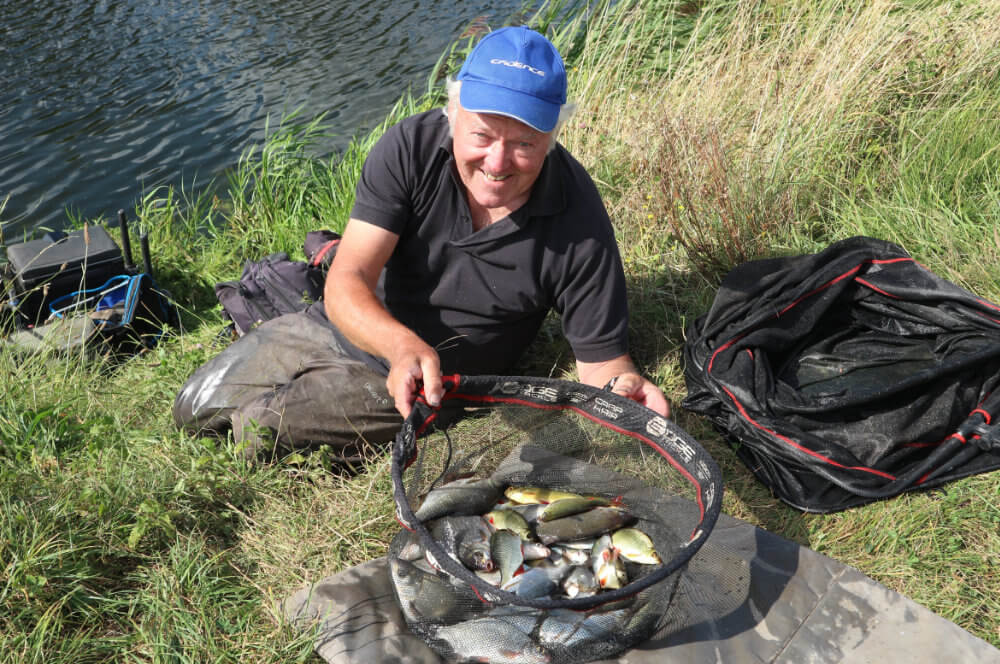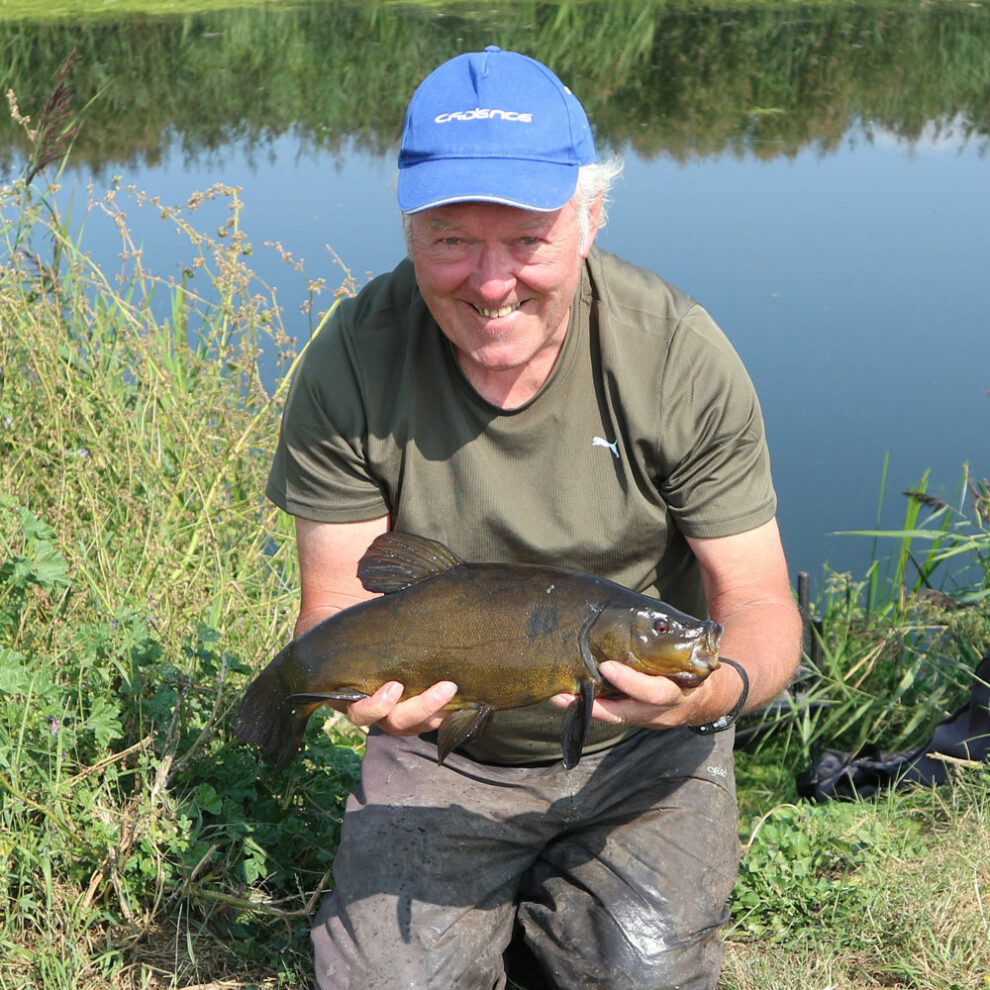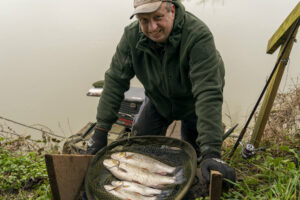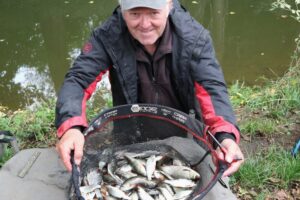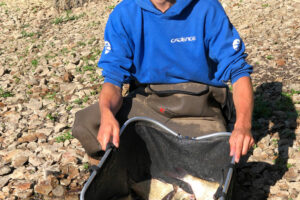Depth Finding
Returning to Manea Pit, the water was gin clear and didn’t look right for pole fishing, especially in the bright conditions. A CR10 12ft Match #3 rod seemed like a better idea, opting for the extra backbone this model offers, considering big tench can be encountered in this venue. Using a small piece of tungsten putty on the hook, a fair time was spent plumbing up with an insert waggler rig. As is often the case in an old gravel workings, depths were all over the place. It was shallow out in front and over to the right, also very weedy. However, I discovered a deeper channel to the left and the bottom was surprisingly clean there. That was the obvious place to explore, setting the float a few inches over-depth. The plan was to regularly feed soft groundbait laced with casters and micro pellets, along with catapulting larger pellets over the top.
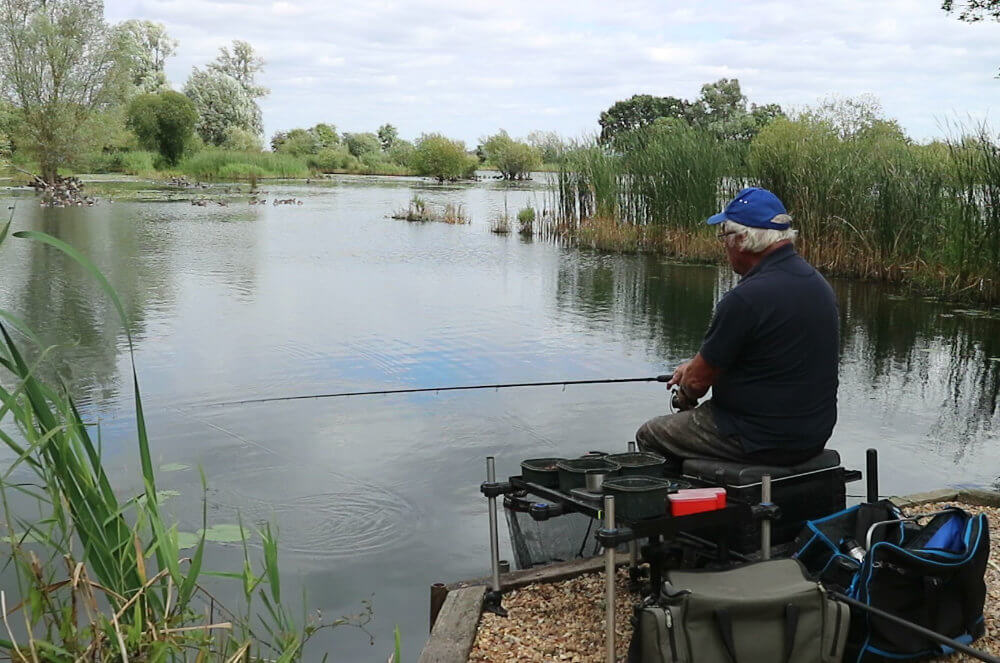
Getting There
With conventional groundbait catapults you have to fire out fair-sized balls of feed to make them work properly, which I didn’t want to do. Pit fish are naturally spooky, tending to back away from heavy disturbance. Putting lots of grub in also potentially attracts big carp, which I wasn’t after. On the nearby fens I’ve developed a way of introducing much smaller balls of groundbait at distance, similar to the loadings a feeder puts in. I use a compact Drennan Revolution loose feed pouch, combined with medium power elastics. It took a while to learn how to fire out walnut sized helpings, holding the catapult upside-down and aiming low. The pouch needs to be dunked in a bait tub full of water every time it’s used, which prevents anything sticking to it. I also flick extra water on each small ball of feed as its formed, so its soft and breaks up fast.
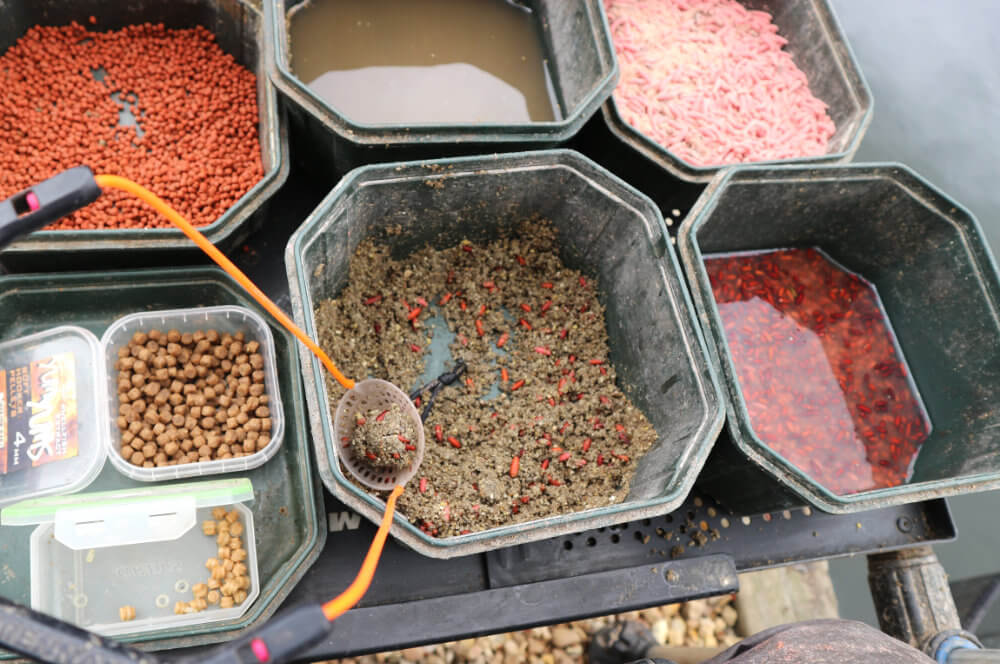
Keeping Busy
Regular scaled down balls of soft groundbait work a treat on waters like this, stirring up the shoals of rudd, roach, and perch to begin with. Feeding pellets over the top provides the option of banding a hard offering to get through the small stuff if required. On this occasion, I caught plenty on caster while waiting for something big to arrive. When clouds of bubbles started erupting over the feed area, a switch to a banded pellet avoided any small fish interest as the tackle settled, gaining enough time for one of the bubblers to find it. I was using 5lb Edge Sinking Mono, with 0.15 mm Edge Premium Line as a hook length, which was needed. Suddenly, there was a big bend in the rod as the waggler rig was tested to its limits, with something lively and heavy trying every trick in the book to get away. That was the first of a brace of bonus tench.
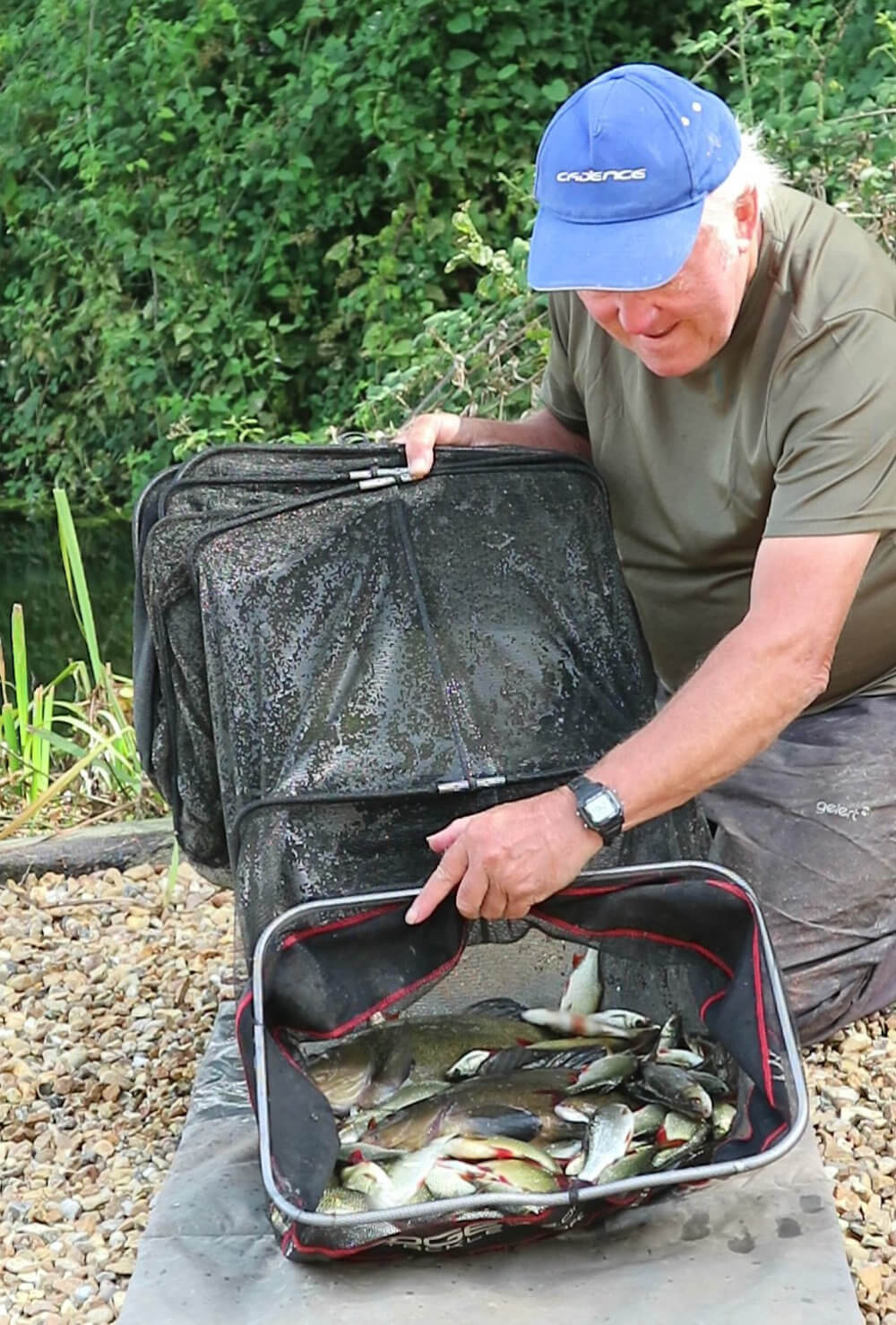
Another Approach
Always interested in trying different things, I revisited the same swim a week later, only this time feeding slightly wetted 3 mm micro pellets as far as was possible with a powerful catapult. I managed to gain the same distance casters were reaching, which were also fed regularly. It took much longer for anything to arrive, compared to the soft groundbait approach. All I got the first hour were a couple of ghost-like bites, where the float dithered and bobbed under with no contact made. Plugging away, rudd turned up first, keeping me busy for a while. A few roach also appeared, but it was a lot slower than before. It took even longer before the first sign of any bubblers, just as I was about to pack up. This cracking tench saved the day. Micro pellets have worked well for me in the past instead of groundbait, but were not so effective in this instance.
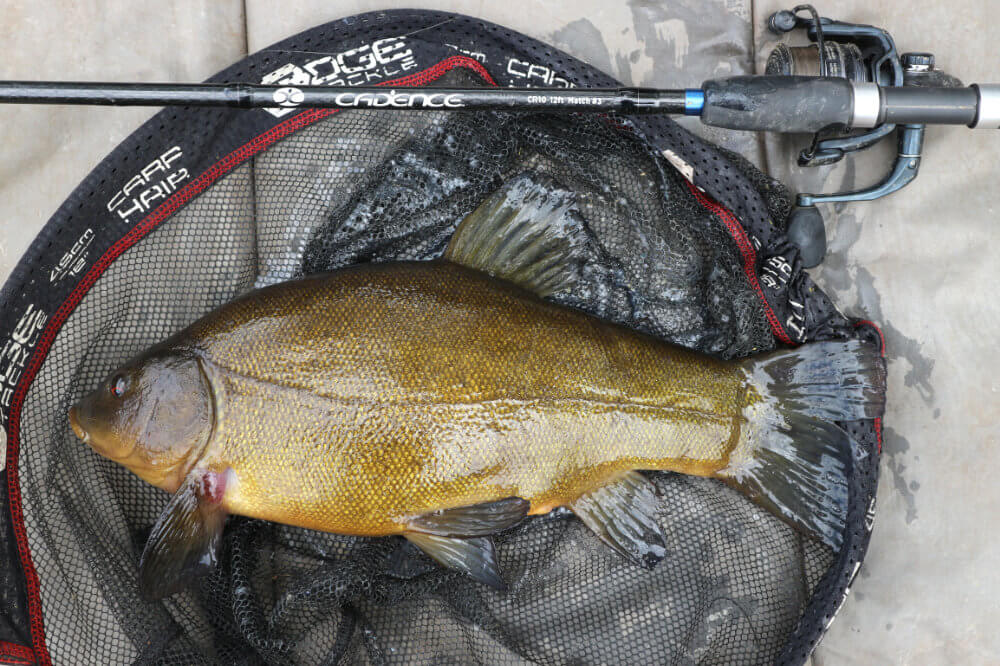
Whip Time
Back on the drains, joined by my mate Andy, we decided to have a go with our Cadence CP200 Whips again. Fishing to hand at 5 to 6 metres was very effective this summer, feeding regular balls of groundbait over 2g pole floats. Casters proved the best bait, although pinkies, red maggots and segments of worm all caught plenty. Hard pellets worked well last year when quality fish were present, but weren’t as good this time around. It was still a good idea to mix a few micros into groundbait mixes, which opened the opportunity of occasionally trying a soft expander on the hook. They’ve caught me a plenty of bonus skimmers when bites have been iffy on other baits. I suddenly spotted Andy’s whip bent into something big and powerful. Going up the high bank to take a look, it was a tench, which were turning up everywhere this summer.
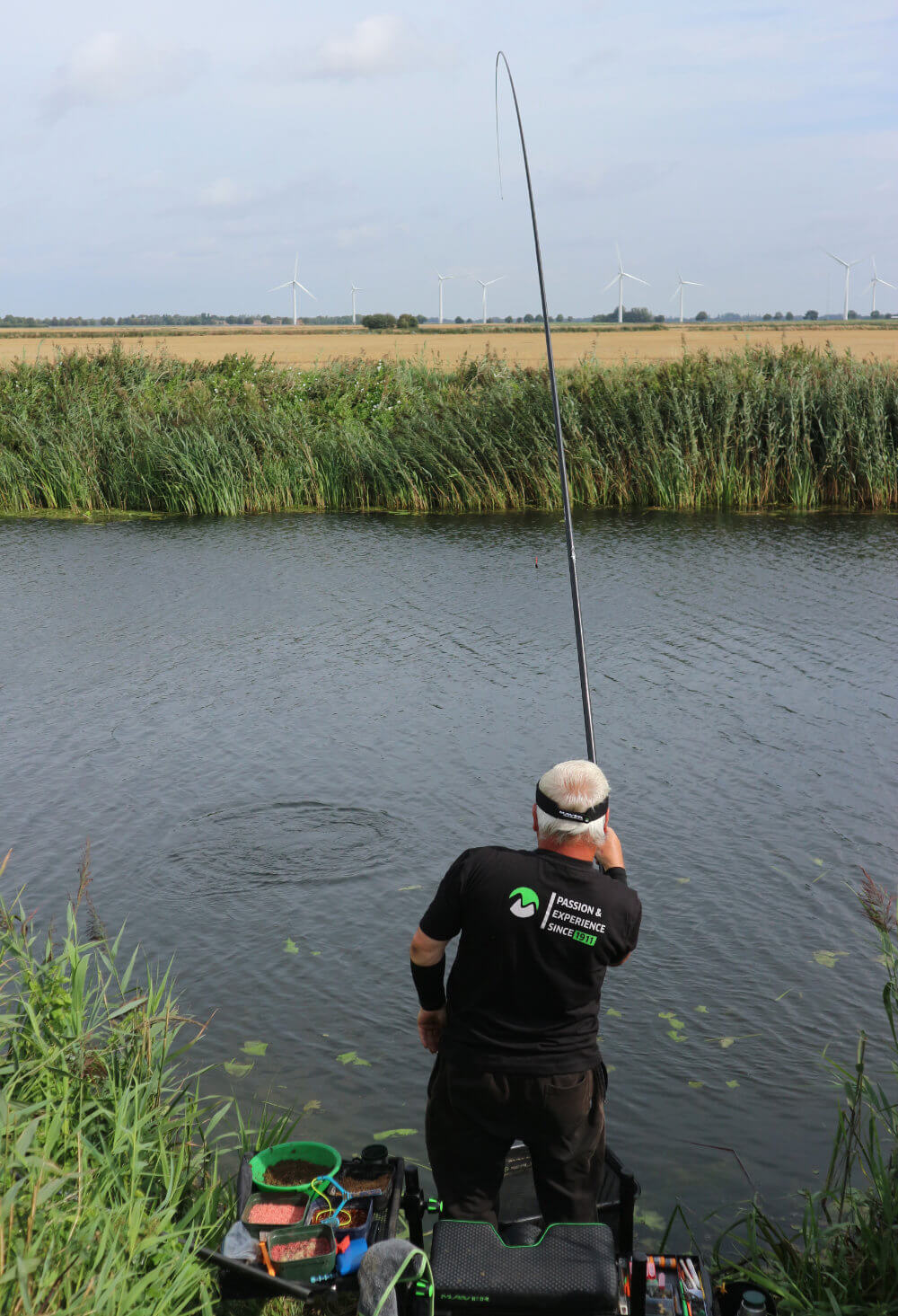
More Surprises
Last time I fished this peg it was crammed with small stuff, while on a revisit better-quality skimmers turned up. I started at 6 metres to hand, but found it wasn’t quite right. The fish were closer in, hugging the banks of nearside floating weed, probably feeling safer in the clear water conditions. I shortened down to 5 metres, having to work hard to gain positive bites by inching the tackle through slightly over-depth. I suddenly hooked into something much bigger, which put up a good scrap, turning out to be a 3lb bream. That fish coughed up several pieces of fresh-looking sweetcorn in my landing net, which prompted me to ask Andy if he was feeding any. He said no and as we were the only anglers in sight, it made me wonder how far fish travel and where this one came from. A bonus tench capped off another fascinating whip session.
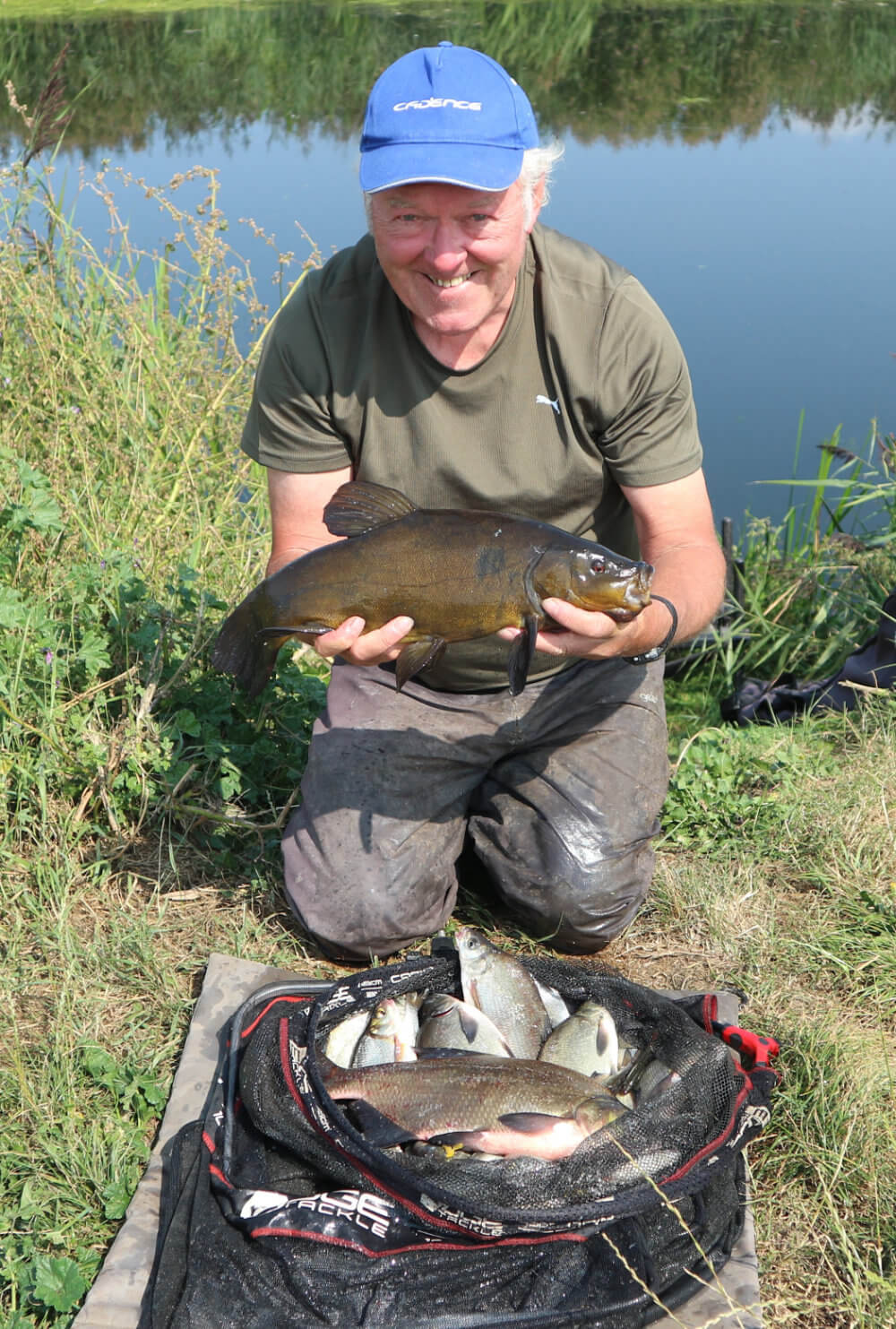
Manea Magic
I had been enjoying catching crazy numbers of small rudd at Manea Fisheries on the top lake, but wanted to have another go on the lower pool. Last go at this spot, which used to be joined to the other water, I waded through loads of small carp and then enjoyed building a nice bag of rudd, roach, and skimmers. This time I put out two keepnets, to discover what the score was regarding the dominant species. I find it difficult to understand why this Silver Fish Lake rarely sees anyone, while the nearby Carp Pool is often packed. It’s a strange strip shape, similar to the nearby drains in appearance, with an island of reeds at the top end. With so many lively carp, I kept well away from the jungle of stems, having experienced before how the bigger fish like trashing your pole rigs in there. As before, it was a bite a chuck, even before I fed anything.
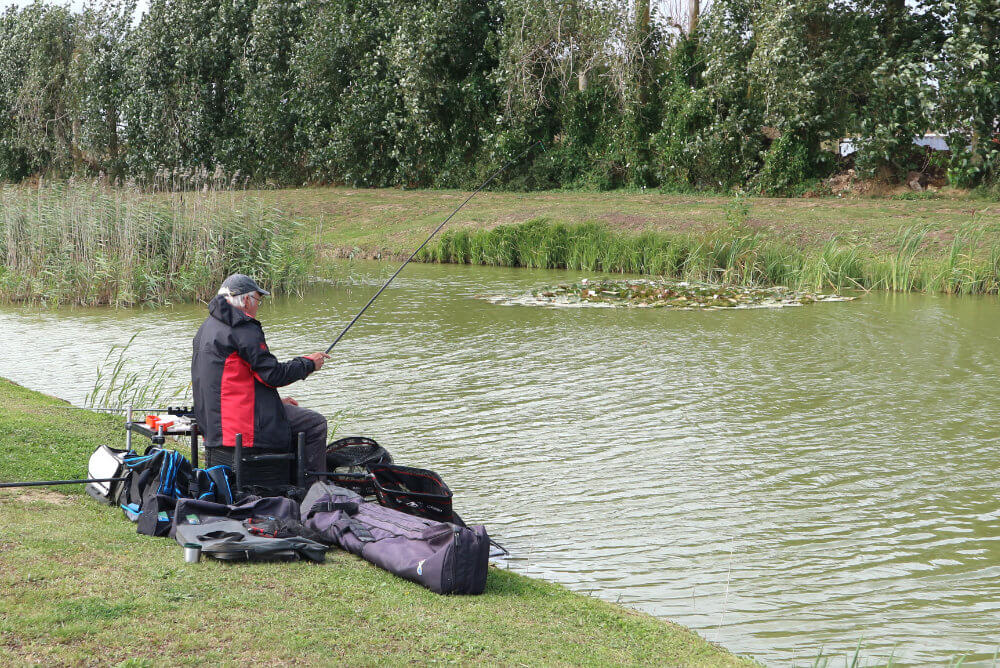
Perfect Playground
I kept things simple with two elasticated top kits, both fitted with Edge Hybrid Solid Latex: 3-4 Orange with a shallow rig and 4-6 Green for a full depth one. Both relied on 0.12 mm Edge Premium Mono hook lengths, attached to 0.15 mm main line. It was crazy, with rudd flashing on the surface when I fed anything and hungry carp deeper down, if I managed to get hook baits through to them. It didn’t matter if I used the shallow set up, or the deeper and heavier full depth one, the rudd were on both straight away. They are a bigger average size in this lake for some reason, but just as ravenous. After caning them for a while, I tried feeding casters and micro pellets in hard balls of groundbait, dumping my deeper rig in to get through. This resulted in a string of lively F1s and small semi-scaled mirror carp. I still had the place all to myself.
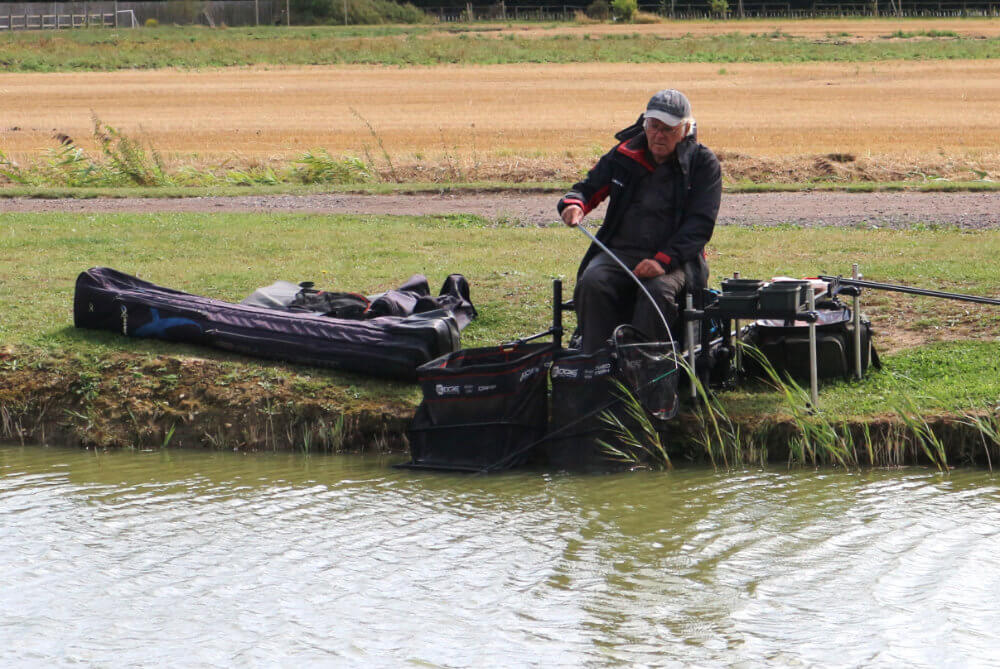
Close Thing
A pattern emerged where packs of F1s would barge in and then back off, while the rudd were never far away. A few skimmers turned up as well, along with odd roach and hybrids. I did hook one big carp, which cleverly managed to transfer my hook into a sunken reed stem a long way off. It was a close call between the carp and silvers, although I think the latter just edged it. This amazing place left me even more confused as to why it’s largely ignored, then again that allows me to make the most of it when I fancy something different. I like venues like this for testing out new gear because it’s always guaranteed to get a hammering. The subtle differences between the orange and green Edge Hybrid Solid Latex worked a treat. I hardly bumped anything on the shallow orange rig, while the extra power the green offered was perfect for lively carp.
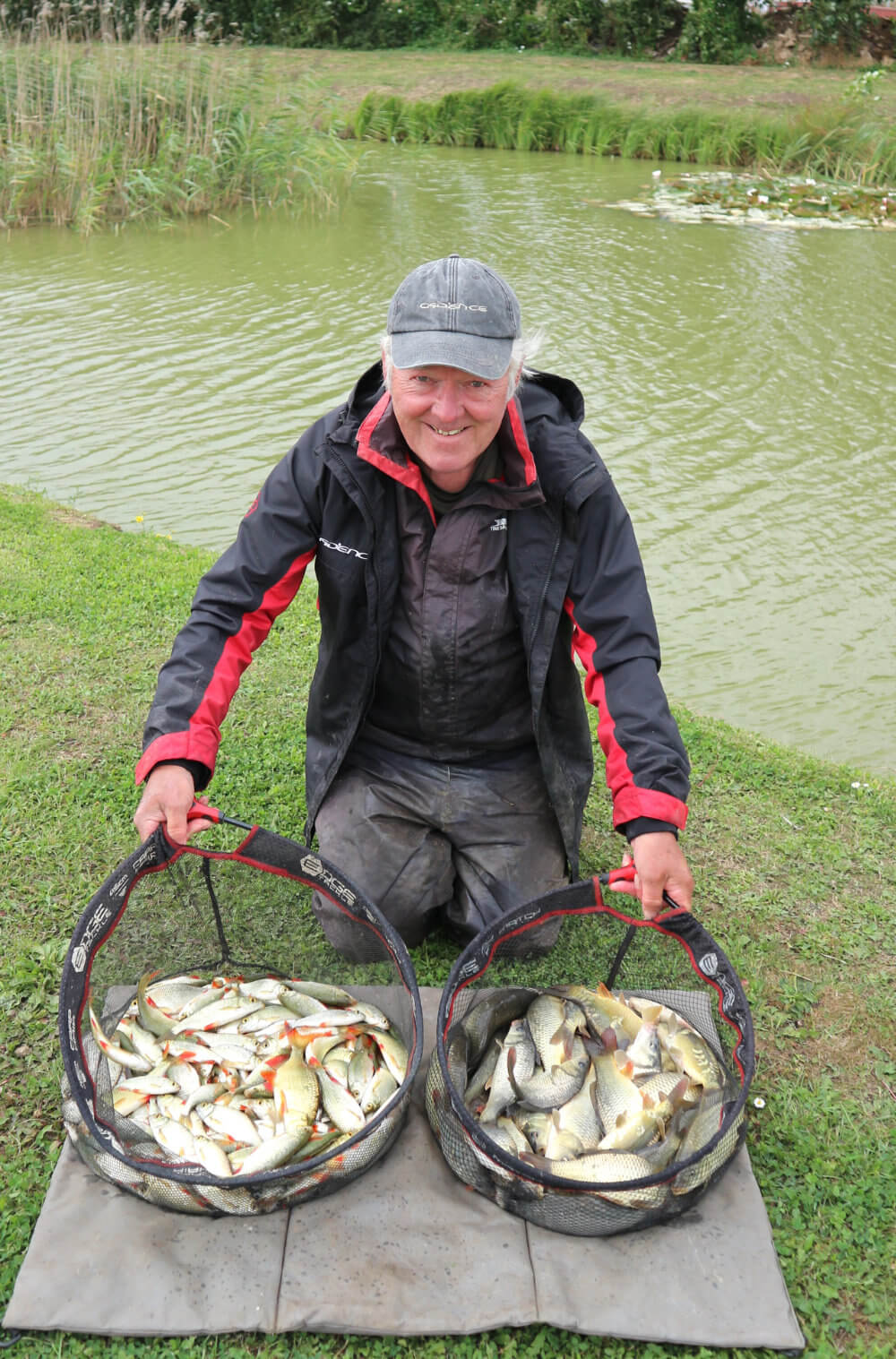
Fenland Puzzle
Still getting to know the fens, where many match sections are hidden away down a maze of country roads, I followed Andy Griffiths to a stretch on the Middle Level. He fished a Kings Lynne match here recently, and we would never have found the place otherwise. They have sections dotted around various outposts, mainly where there are places to park and easier access. This spot was by a bridge, not far from the village of Outwell. It’s well known for skimmers apparently, but the weights were not brilliant on a recent King of the Fens Event Andy framed in. He wanted to learn more, trying out different things with a long pole and 6 metre whip, while I opted for a groundbait feeder. This drain is much wider and deeper than the ones we’ve been frequenting in March and Benwick, perfect for a feeder, an approach I’d been missing out on for a while.
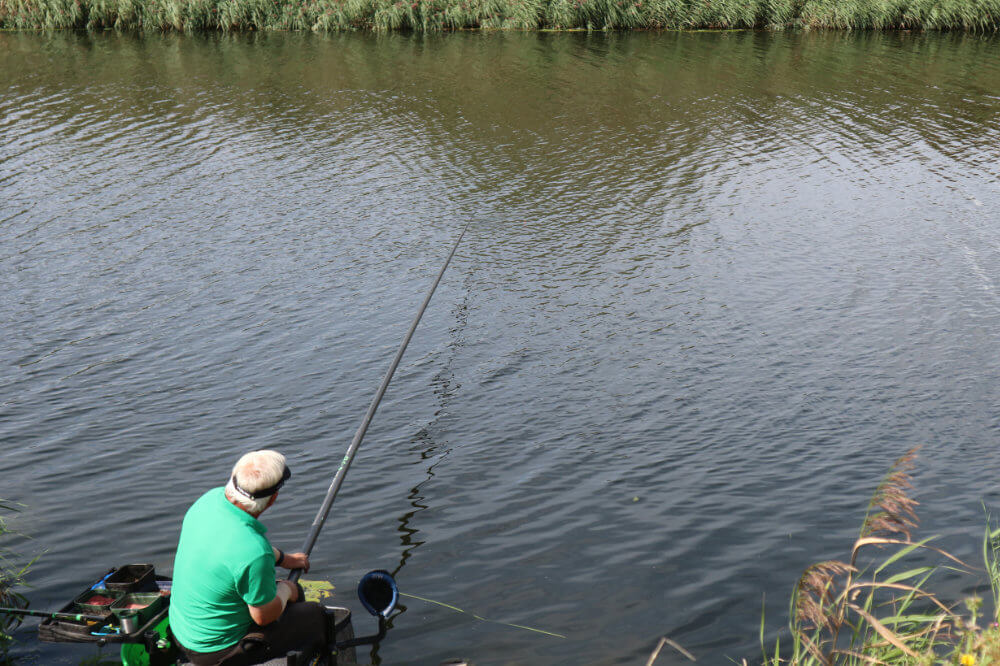
Another Level
The Middle Level is a big challenge, offering a vast amount of water to draw fish from. It was quite windy at times due to the flat nature of the surrounding terrain, even with only a light breeze forecast. I decided to set up my CR10 Cadence 11ft Feeder Rod #2, which would allow switching between Edge 20g Groundbait and Edge Plastic Cage feeders. I aimed to kick off with a 50 cm fluorocarbon hook length, casting over to the far bank ledge, where there was good depth. I used to fish nearby Ten Mile Bank on the Ouse Relief Channel many years ago, and similar tactics worked well there. This place also reminded me of the River Suck in Ireland, where again a far side feeder approach scored with bream, rudd, and hybrids. I didn’t bother setting up anything else, wanting to enjoy getting back into studying a sensitive carbon quivertip again.
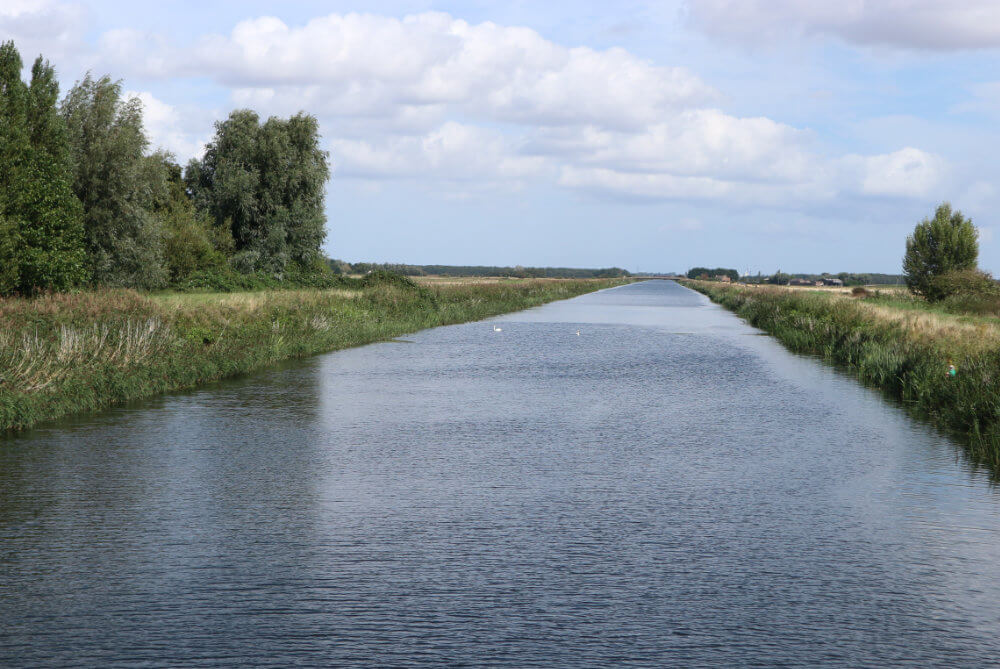
Feeder Time
I was quickly reminded that big drain fishing is rarely easy. To begin with, I was getting numerous slight indications in the clear water, reeling back sucked maggots. The culprits were either small rudd or tiny skimmers. I tried dropping down a hook size, which helped. As I built the swim up with regular casting, better skimmers turned up and I also started catching chunky rudd on-the-drop. The latter prompted a switch to a longer, slower falling hook length, but that didn’t highlight when baits were getting mangled again. Going back to 50 cm, and then 40 cm, worked more efficiently. Andy bagged up on the pole, also landing another bonus big tench on his Cadence CP200 Whip, but I wasn’t about to change tack. It was enjoyable working things out, eventually nailing everything harder on the deck with a groundbait feeder, well pleased with this haul.
